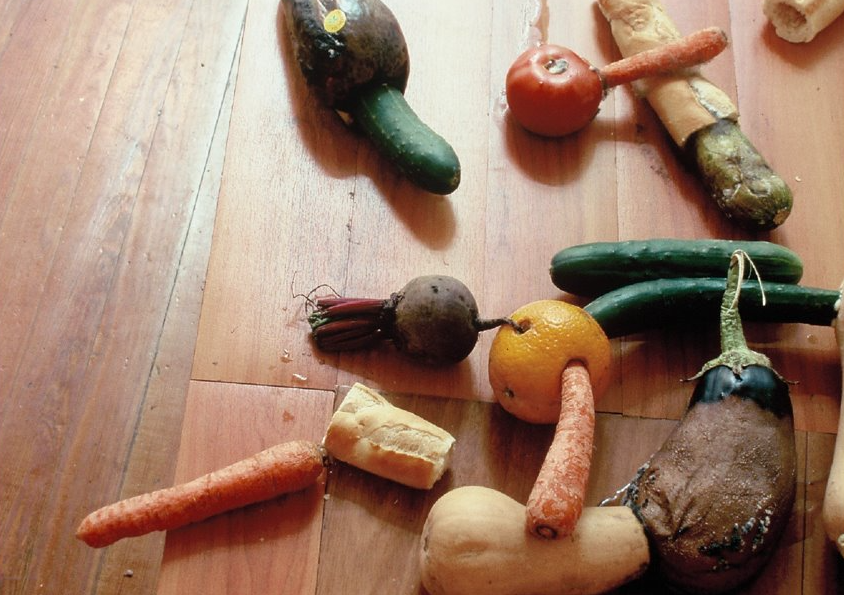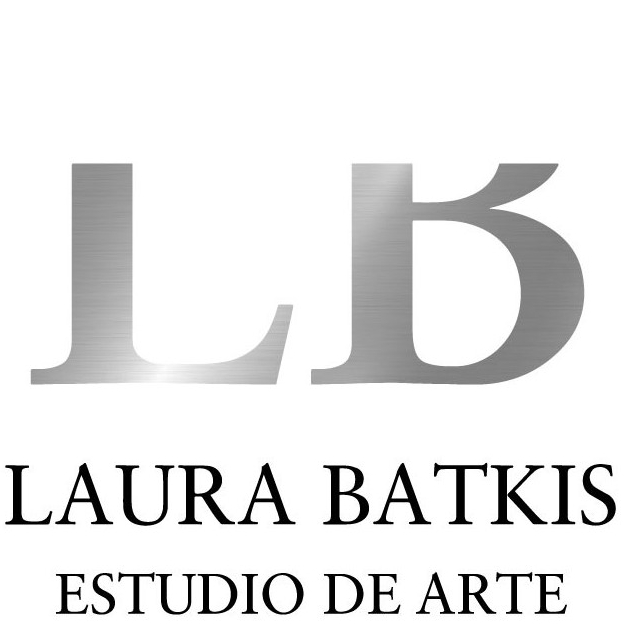La Mano
Diego Bianchi – Imperialism Minimalism
No. 27 – June 2006

He is a perfect example of a new tendency manifested in the art of the 2000’s generation: installations with decomposing elements, smell, flies, noise. Laura Batkis accepted the challenge, took off her shoes, went up a ramp and got this interview along with a couple of bruises.
Diego Bianchi (1969) is a graphic designer. He studied with Pablo Siquier and won a scholarship given by Guillermo Kuitca. In 2002 he had his first exhibition, in 2004 one of his pieces was acquired by the Malba (Buenos Aires Museum of Latin American Art) and he has just presented his exhibition Imperialismo Minimalismo (Imperialism Minimalism) at the Alberto Sendrós gallery. He uses the whole repertoire of styles of post-modernity as an archive of resources from which he later selects some in a fragmentary way. The situationism of action art, the detachment from Dada and the colorful consumerism of pop. To finance his exhibition, he sent the photograph Tiempo Compartido (Shared time) to one hundred people along with a text intimidating them to buy it for one hundred pesos or return it. In the era of consumerism, Bianchi reveals the current marketing strategies of wild capitalism which promote the erasure of personal desire with the dubious illusion of eliminating existential anguish under the VIP protection of a cigarette brand.
Laura Batkis: How did you come up with the title of the exhibition?
Diego Bianchi: In my work there has always been a secret tension with minimalism and I decided to finally make it explicit.
LB: But your exhibition is completely baroque and chaotic…
DB: I wanted to broaden the concept of minimalism, to redefine the term, trying to extend its life in some way or to give it another chance.
LB: Historically, the definition of minimalism is “less is more”. What is your definition of this trend?
DB: If you look at the pieces in this installation individually, the workings are very simple. What happens is that there are many situations and they all overlap. Accumulation is what contradicts it. Although, as I was recently pointed out, what the definition of minimalism finally means is the intention to conquer more. I hadn’t thought about it and it seemed revealing to me.
LB: You use minimalism to contradict it.
DB: Yes, minimalism used specific objects, avoiding all references. I use objects in the same sense but I try to multiply the references as much as possible.
LB: Like in one of your works where the pieces of a game of checkers are soda pop caps.
DB: It’s a game that represents a war, it’s about eliminating the other and conquering his territory. I replace black and white with marked caps. Notice that I set up a board of Pepsi against Coca Cola, Sprite against Seven Up, Fanta against Mirinda.
LB: Then the minimalism is enlarged by generating several simple scenes that put together expand the very concept of what’s minimal.
DB: The minimalist idea invaded everything, art, electronic music, decoration, it was a decade of bars built with smoothed cement. The critical intention at the beginning was to make us realize that the days of the empire of minimalism are almost over. Later I found other meanings less straightforward but more interesting for me. For example in the formation of an army: all identical individuals standing one behind the other under strict geometry, the arrangement of products in the windows or on the supermarkets shelves. Reading that as minimalism and finding aesthetic sense in those things seemed important to me.
LB: Like in the war of the plasticolas (glues)…
DB: Yes, armies of Uhus, the glue stick against the common school plasticolas. Products that because of certain factors displace others both in their use and in the market. The yellow, meticulous and efficient army is coincidentally of German origin and advances on the national blue and white plasticolas, cornered and with many casualties in their lines. The dozens of weevils devouring the bread can also be seen as an army or a horde. There was a whole banana that looked deflated, they were eating it from the inside.
LB: There is a tone of war for survival, of winners and losers.
DB: Yes, with that intention I also used camouflage, but on top of absurd things like a cleaning stick, a small table or a broom. I join the obsession of making war fashionable.
LB: You also pervert style, by setting the neon tubes as a reference to Dan Flavin, but instead of being lit they are all burnt tubes. You take the styles of the imperialism of art and you make them ordinary, banal, you take them down from the pedestal of great art.
DB: Something like that. I contaminate it a little, I disrespect them or conversely I transform cardboard into minimal decoration. Like in the walls armed with “chapadur” collected from the street, I arranged them neatly as if they were slabs from a Mar del Plata style house. When I am preparing an exhibition I think that everything can be taken inside the gallery.
LB: In the mud volcanoes with orange Fanta and grapefruit drink Quatro there is a certain irony with land art (interventions in the landscape). There is something of artificial nature inside the gallery.
DB: Yes, because in addition to individual pieces, I try to think of the installation as a landscape where urban experience is infiltrated and present in every way. The tent as a possible home within that context, the cut down sequoias, simulated with adhesive paper that imitates wood, mud volcanoes but with orange and grapefruit Fanta inside.
I imagined the inhabitant of this place as if he were a collector of signs: bundles of cigarettes without their packs, old flip-flops and shoes, summer promotion books, cardboard rolls from the inside of the toilet paper, old rags. As a sample book of chosen souvenirs, like the three “balerinas” in three different states of decay. And the T-shirts with Italian inscriptions I arranged on the ceiling like a flock. They are an invasion in Buenos Aires. It surprises me how something absolutely banal can suddenly become such a massive phenomenon.
LB: Your exhibition looks like a data machine, there is an overwhelming amount of information.
DB: Yes, I use the information that comes in without even looking for it. Think about all the information that comes to you in a newspaper on a Sunday, including the flyers and the advertisements. I set them up like a waterfall on the wall, creating a competition among all the Sunday newspapers to see which had the biggest display.
LB: Somehow you record the passing of time. Like with the fruits that are rotting during the exhibition.
DB: I made an orgy of fruits, they touch each other, they penetrate each other, which could happen in the bottom drawer of some broken refrigerator, then they start to rot and their mosses get infected.
LB: The word Imperialism has ideological connotations. Did you work with that sense of the term?
DB: Yes, there are omnipresent presences in everyday life such as soccer, brands, music, information, noise. They are things so constant that we almost stop noticing them.
LB: The invasion of brands as a place of belonging to a certain urban tribe.
DB: I don’t make a moral judgment about it, I’m attentive to what happens, brands give names to parties and the most massive festivals, but afterwards I don’t smoke a Camel, nor do I drink Brahma beer. Like the soccer that is on TV in all the bars or MTV, we hardly see it and what we are listening to simultaneously is the music on the radio. It is dyslexia.
LB: Suddenly there is a local tone, like the red ovenbird.
DB: Like a kind of natural resistance, but it is in an invasive condition too, mounted on a TV stand, that in this landscape replaces the spot where the tree should be.
LB: This whole exhibition is a great battle.
DB: Yes, maybe, I’ve been told it has a militaristic tone.
LB: Even in the way you make the viewer enter your show, climbing a ramp almost hanging from a rope.
DB: I wanted to make it challenging to see it. I wanted to put some kind of difficulty in seeing it. I first thought about an economic challenge, that people would have to pay to get in. Then I gave up and turned my mind to a physical difficulty. Ascending, crawling, climbing the steps and the platform where I placed the receptionist’s desk to then cross over to the other side where this pseudo-natural heaven, this refuge, is located. I wanted the viewer to make an effort, to pass a test in order to see the exhibition, to warm up before starting watching.
LB: Like a happening.
DB: Yes, I like the work of the Brazilian Oiticica, and from here I am very interested in all the work that Marta Minujín did.
LB: If someone can’t climb the ramp, they won’t be able to see your show?
DB: I wish everyone could go up, but it was also part of the concept of this imperialism-fascism that I wanted to talk about. There are many situations where we are left out for different reasons. The world is organized in groups and there are cutouts of all kinds. I am expressing a current state of things where for example being young is a safeguard.
All the galleries in the city center have access stairs, so I thought the ramp, if you’re disabled, represents Argentine contemporary art had already left you out.
LB: You have to be strong to enter, and then make an effort to try to understand what all this is about.
DB: I’m not so worried about people interpreting what I thought. I know that’s very difficult to happen and it doesn’t make much sense either. I prefer to generate an atypical sensation with absolutely familiar things, to generate aesthetic situations from the things that surround us, to think together about these things.
BY LAURA BATKIS
